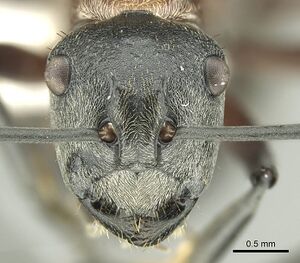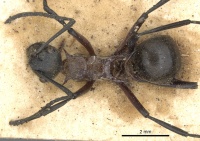Polyrhachis fervens
| Polyrhachis fervens | |
|---|---|

| |
| Scientific classification | |
| Kingdom: | Animalia |
| Phylum: | Arthropoda |
| Class: | Insecta |
| Order: | Hymenoptera |
| Family: | Formicidae |
| Subfamily: | Formicinae |
| Tribe: | Camponotini |
| Genus: | Polyrhachis |
| Subgenus: | Hedomyrma |
| Species: | P. fervens |
| Binomial name | |
| Polyrhachis fervens Smith, F., 1860 | |
| Synonyms | |
| |
Can be found nesting in the dry hollow stems of bamboo.
Identification
Kohout (2008) - There are two members of the subgenus Hedomyrma present in Sulawesi:
- Distinctly bicoloured; head and tarsi black with mesosoma, petiole and femora light reddish-brown; gaster and tibiae distinctly darker . . . . . Polyrhachis fervens
- Unicoloured; black throughout (in copal) . . . . . Polyrhachis circumdata
Distribution
The distribution of P. fervens extends from eastern Indonesia (Halmahera, Seram and Ambon Is) to New Guinea and south to Cape York Peninsula, Queensland. It is known from lowland rainforests at Bamaga near the tip of Cape York Peninsula and at Iron Range.
Latitudinal Distribution Pattern
Latitudinal Range: -3.28° to -24.41667°.
| North Temperate |
North Subtropical |
Tropical | South Subtropical |
South Temperate |
- Source: AntMaps
Distribution based on Regional Taxon Lists
Australasian Region: Australia (type locality).
Indo-Australian Region: Indonesia (type locality), New Guinea, Sulawesi.
Distribution based on AntMaps
Distribution based on AntWeb specimens
Check data from AntWeb
Countries Occupied
| Number of countries occupied by this species based on AntWiki Regional Taxon Lists. In general, fewer countries occupied indicates a narrower range, while more countries indicates a more widespread species. |

|
Estimated Abundance
| Relative abundance based on number of AntMaps records per species (this species within the purple bar). Fewer records (to the left) indicates a less abundant/encountered species while more records (to the right) indicates more abundant/encountered species. |

|
Biology
Castes
Worker
Images from AntWeb
   
| |
| Worker. Specimen code casent0906731. Photographer Michele Esposito, uploaded by California Academy of Sciences. | Owned by NHMUK, London, UK. |
Nomenclature
The following information is derived from Barry Bolton's Online Catalogue of the Ants of the World.
- fervens. Polyrhachis fervens Smith, F. 1860b: 101, pl. 1, fig. 26 (w.) INDONESIA (Ambon I.). Combination in P. (Dolichorhachis): Emery, 1925b: 189; in P. (Hedomyrma): Dorow, 1995: 27; Bolton, 1995b: 348. Senior synonym of indocilis, kershawi, valerus: Kohout, 1988c: 434.
- valerus. Polyrhachis valerus Smith, F. 1861b: 40, pl. 1, fig. 10 (w.) INDONESIA (Sulawesi). Combination in P. (Hedomyrma): Emery, 1925b: 190. Junior synonym of fervens: Kohout, 1988c: 434.
- bicolor. Polyrhachis (Hedomyrma) bicolor Karavaiev, 1927e: 21, fig. 11 (w.) INDONESIA (Ambon I.). [Junior primary homonym of bicolor Smith, above.] Replacement name: indocilis Santschi, 1928h: 139.
- indocilis. Polyrhachis (Hedomyrma) indocilis Santschi, 1928h: 139. Replacement name for bicolor Karavaiev, 1927e: 21. [Junior primary homonym of bicolor Smith, F. 1858b: 65.] Junior synonym of fervens: Kohout, 1988c: 434.
- kershawi. Polyrhachis (Hedomyrma) kershawi Clark, 1930c: 12, fig. 1 (w.) AUSTRALIA. Junior synonym of fervens: Kohout, 1988a: 434.
Unless otherwise noted the text for the remainder of this section is reported from the publication that includes the original description.
Description
Type Material
Kohout (2008) - Holotype worker. INDONESIA, Ambon I. (A. R. Wallace), Oxford University Museum of Natural History(examined).
- Polyrhachis fervens: Syntype, worker(s), Amboyna, Indonesia.
- Polyrhachis (Hedomyrma) kershawi Clark, 1930: Syntype, worker(s), Claudie River, Queensland, Australia, Australian Museum.
- Polyrhachis (Hedomyrma) kershawi Clark, 1930: Syntype, worker(s), Claudie River, Queensland, Australia, Museum Victoria, Melbourne.
Kohout (1988) - Prof. Radchenko of the Zoological Institute, Kiev, informs me that the unique holotype of Karawajew's homonym P. bicolor cannot be found in the Karawajew collection, and is presumed lost. However, the original description and illustration are sufficient to establish its synonymy beyond reasonable doubt.
The following notes on F. Smith type specimens have been provided by Barry Bolton (details):
Polyrhachis fervens
Holotype worker in Oxford University Museum of Natural History. Labelled “Amb.” (= Ambon I.) and with a Donisthorpe type-label.
Polyrhachis valerus
The specimen in Oxford University Museum of Natural History labelled as type by Donisthorpe matches the rather poor description well, but the data label upon it reads “Men.” (= Manado, Sulawesi). The type-loclaity recorded by Smith is “Celebes, Tondano.”
References
- Bolton, B. 1995b. A new general catalogue of the ants of the world. Cambridge, Mass.: Harvard University Press, 504 pp. (page 348, Combination in P. (Hedomyrma))
- Dorow, W. H. O. 1995. Revision of the ant genus Polyrhachis Smith, 1857 (Hymenoptera: Formicidae: Formicinae) on subgenus level with keys, checklist of species and bibliography. Cour. Forschungsinst. Senckenb. 185: 1-113 (page 27, Combination in P. (Hedomyrma))
- Emery, C. 1925d. Hymenoptera. Fam. Formicidae. Subfam. Formicinae. Genera Insectorum 183: 1-302 (page 189, Combination in P. (Dolichorhachis))
- Imai, H.T., Kihara, A., Kondoh, M., Kubota, M., Kuribayashi, S., Ogata, K., Onoyama, K., Taylor, R.W., Terayama, M., Yoshimura, M., Ugawa, Y. 2003. Ants of Japan. 224 pp, Gakken, Japan.
- Kohout, R. J. 1988c. Nomenclatural changes and new Australian records in the ant genus Polyrhachis Fr. Smith (Hymenoptera: Formicidae: Formicinae). Mem. Qld. Mus. 25: 429-438 (page 434, Senior synonym of indocilis, kershawi and valerus)
- Kohout, R.J. 2008a. A review of the Polyrhachis ants of Sulawesi with keys and descriptions of new species (Hymenoptera: Formicidae: Formicinae). Memoirs of the Queensland Museum. 52:255-317.
- Latumahina, F., Borovanska, M., Musyafa, Sumardi, Susetya Putra, N., Janda, M. 2015. Ants of Ambon Island – diversity survey and checklist. ZooKeys 472, 43–57 (doi:10.3897/zookeys.472.8441).
- Radchenko, A.G., Fisher, B.L., Esteves, F.A., Martynova, E.V., Bazhenova, T.N., Lasarenko, S.N. 2023. Ant type specimens (Hymenoptera, Formicidae) in the collection of Volodymyr Opanasovych Karawajew. Communication 1. Dorylinae, Poneromorpha and Pseudomyrmecinae. Zootaxa, 5244(1), 1–32 (doi:10.11646/zootaxa.5244.1.1).
- Smith, F. 1860b. Catalogue of hymenopterous insects collected by Mr. A. R. Wallace in the islands of Bachian, Kaisaa, Amboyna, Gilolo, and at Dory in New Guinea. J. Proc. Linn. Soc. Lond. Zool. 5(17b)(suppl. to vol. 4 4: 93-143 (page 101, pl. 1, fig. 26 worker described)
References based on Global Ant Biodiversity Informatics
- Chapman, J. W., and Capco, S. R. 1951. Check list of the ants (Hymenoptera: Formicidae) of Asia. Monogr. Inst. Sci. Technol. Manila 1: 1-327
- Donisthorpe, Horace. 1943. The Ants of Waigeu Island, North Dutch New Guinea. The Annals and Magazine of Natural History 11 (10): 433-475.
- Emery C. 1886. Saggio di un catalogo sistematico dei generi Camponotus, Polyrhachis e affini. Memorie della Reale Accademia delle Scienze dell'Istituto di Bologna 5: 363-382
- Emery C. 1887. Catalogo delle formiche esistenti nelle collezioni del Museo Civico di Genova. Parte terza. Formiche della regione Indo-Malese e dell'Australia. [part]. Ann. Mus. Civ. Stor. Nat. 24(4): 209-258.
- Emery C. 1901. Formiciden von Celebes. Zoologische Jahrbücher. Abteilung für Systematik, Geographie und Biologie der Tiere 14:565-580.
- Emery, C. "Catalogo delle formiche esistenti nelle collezioni del Museo Civico di Genova. Parte terza. Formiche della regione Indo-Malese e dell'Australia." Annali del Museo Civico di Storia Naturale Giacomo Doria (Genova) (2) 4, no. 24 (1887): 209-258.
- Janda M., G. D. Alpert, M. L. Borowiec, E. P. Economo, P. Klimes, E. Sarnat, and S. O. Shattuck. 2011. Cheklist of ants described and recorded from New Guinea and associated islands. Available on http://www.newguineants.org/. Accessed on 24th Feb. 2011.
- Karavaiev V. 1930. Ameisen von den Molukken und Neuguinea. (Ergebnisse der Sunda-Expedition der Notgemeinschaft der deutschen Wissenschaft 1929/30.). Zool. Anz. 92: 206-214.
- Kohout R. J. 1988. Nomenclatural changes and new Australian records in the ant genus Polyrhachis Fr. Smith (Hymenoptera: Formicidae: Formicinae). Memoirs of the Queensland Museum 25: 429-438
- Kohout, R. J. 2008. A review of the Polyrhachis ants of Sulawesi with keys and descriptions of new species (Hymenoptera: Formicidae: Formicinae). Memoirs of the Queensland Museum 52:255-317.
- Latumahina F., M. Borovanska, N. S. Putra, and M. Janda. 2015. Ants of Ambon Island diversity survey and checklist. ZooKeys 472: 4357.
- Robson Simon Ant Collection, 05-Sept-2014
- Robson Simon Database Polyrhachis -05 Sept 2014
- Smith F. 1861. Catalogue of hymenopterous insects collected by Mr. A. R. Wallace in the islands of Ceram, Celebes, Ternate, and Gilolo. [part]. Journal and Proceedings of the Linnean Society of London. Zoology 6: 36-48.
- Smith F. 1863. Catalogue of hymenopterous insects collected by Mr. A. R. Wallace in the islands of Mysol, Ceram, Waigiou, Bouru and Timor. Journal and Proceedings of the Linnean Society of London. Zoology 7: 6-48.
- Snelling R. R. 1998. Insect Part 1: The social Hymenoptera. In Mack A. L. (Ed.) A Biological Assessment of the Lakekamu Basin, Papua New Guinea, RAP 9. 189 ppages
- Viehmeyer H. 1912. Ameisen aus Deutsch Neuguinea gesammelt von Dr. O. Schlaginhaufen. Nebst einem Verzeichnisse der papuanischen Arten. Abhandlungen und Berichte des Königlichen Zoologischen und Anthropologische-Ethnographischen Museums zu Dresden 14: 1-26.
- Viehmeyer H. 1914. Papuanische Ameisen. Deutsche Entomologische Zeitschrift 1914: 515-535.

